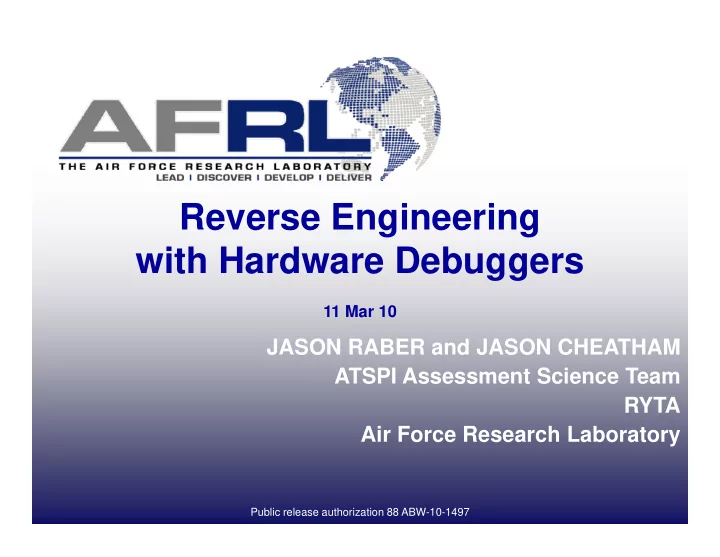

Reverse Engineering with Hardware Debuggers 11 Mar 10 11 Mar 10 JASON RABER and JASON CHEATHAM ATSPI Assessment Science Team ATSPI Assessment Science Team RYTA Air Force Research Laboratory Public release authorization 88 ABW-10-1497
2 Outline • Architecture • Breakpoints • Breakpoints • Hypervisors Hypervisors • Macros
The Hard Way Hardware debugger / in-target probe (ITP) / in-circuit gg g p ( ) emulator (ICE) Socket CPU 3
Friends with Benefits • Hardware debuggers can see almost everything • They live outside the OS, so even kernel mode rootkits can’t hide • Rewriting firmware • They’re OS independent – Just needs a compatible x86 processor J t d tibl 86 4
5 The Softer Side
6 Outline • Architecture • Breakpoints • Breakpoints • Hypervisors Hypervisors • Macros
Ways to Break Things • Hardware Breakpoints – DR registers DR registers • Software Breakpoints Software Breakpoints – ICEBP (0xF1) instruction + DR7 bit 12 • Infinite loops – Steal a couple bytes and replace with 0xEBFE 7
Infinite Breakpoints • EB FE is a jump to the same address (jmp $) – Inject the infinite loop (0xEBFE) into the application or Inject the infinite loop (0xEBFE) into the application or driver – Halt the CPU when the system freezes, and there you y y are • They’re very easy to use with an ICE C – No worries about freezing the system – Don t have to deal with virtual memory Don’t have to deal with virtual memory • Checksums can detect these, so place them Checksums can detect these, so place them carefully 8
9 Outline • Architecture • Breakpoints • Breakpoints • Hypervisors Hypervisors • Macros
More Power… • Macros can make an define proc pcrange(startaddr, p p g emulator very powerful l t f l endaddr) – Implement complex or define ord4 startaddr repetitive tasks define ord4 endaddr – Detailed control of ICE Detailed control of ICE { { while (1) { if (EIP >= startaddr && • SourcePoint uses a C EIP <= endaddr) { like scripting language like scripting language break – Variables, functions, control } else { flow step 4 – Types have well-defined Types have well defined } widths } • ord1, int4, real8, … } – Control statements for ICE 10
11 Range Breakpoint
Run Trace flist (“tracelog.txt”, 1) define ord4 lasteip = EIP softremove while (1) { if (EIP > if (EIP >= 0xC0000000 && lasteip < 0xC0000000) { 0 C0000000 && lasteip < 0 C0000000) { softbreak = location=lasteip+2 softbreak = location=lasteip+3 softbreak = location=lasteip+4 softbreak = location=lasteip+5 softbreak = location=lasteip+6 lasteip = EIP go } if (EIP != endaddr) { asm eip printf("eax: “); eval eax virtual printf("ebx: “); eval ebx virtual printf("ecx: "); eval ecx virtual printf("edx: "); eval edx virtual printf("esi: "); eval esi virtual printf( esi: ); eval esi virtual printf("edi: "); eval edi virtual printf("esp: "); eval esp virtual lasteip = EIP step } else { nolog stop } } 12
From the Outside In • Emulator access is pretty raw, so we wrote some simple forensic macros simple forensic macros – list_procs() – get_ssdt() g _ () – get_syscall_addr(name) – hook_syscall(name) – list_mods() 13
get_syscall_addr define proc pointer get_syscall_addr(syscall_name) define nstring syscall_name define proc pointer find_gdi_proc() { { define pointer PsActiveProcessHead = get_head_proc() if (syscall_name == "NtCreateProcessEx") { return ssdt_index_to_addr(0x30, 0) define pointer first_proc = flink_to_proc_addr(PsActiveProcessHead) } else if (syscall_name == "NtCreateSection") { return ssdt index to addr(0x32 0) return ssdt_index_to_addr(0x32, 0) define pointer current_flink = next_proc_flink(first_proc) } else { define proc pointer ssdt_index_to_addr(index, table) define pointer current_proc = flink_to_proc_addr(current_flink) printf("Unknown system call\n"); define ord4 index define proc pointer get_ssdt() return 0 { { while (current_flink != PsActiveProcessHead) { } define pointer ssdt = get_ssdt() define pointer gdi_addr = find_gdi_proc() d fi i t di dd fi d di () define ord1 type = proc_type(current_proc) d fi d1 ( ) } define pointer service_table_base = ord4 ssdt define pointer tlh_flink = proc_thread_list_head(gdi_addr) if (type != 0x03) { printf("Non ‐ process type: %x\n", type); break; } return ssdt_service(service_table_base, index) define pointer thread_list_head = flink_to_thread_addr(tlh_flink) } define pointer ssdt = thread_ssdt(thread_list_head) define ord4 w32proc = proc_win32process(current_proc) return ssdt } if (w32proc != 0x0) return current_proc current_flink = next_proc_flink(current_proc) current_proc = flink_to_proc_addr(current_flink) } } } 14
15 Outline • Architecture • Breakpoints • Breakpoints • Hypervisors Hypervisors • Macros
Blue…Something • ICE runs below hypervisors • You can go far with a few simple macros – vmx is enabled vmx_is_enabled – vmx_goto_resume – vmx_guest_eip – vmx_exit_reason 16
17 Down We Go…
Nobody’s Perfect • You can’t single step or trace across the ring -1/0 boundary boundary • Finding the hypervisor is tricky g yp y • Newer VM instructions can cause problems 18
19 The Debuginator Summary
Recommend
More recommend